Updated: August 2020
There is more than one way to bring nature and into your home or workplace so we?re going to break down the difference between moss walls and living walls and give you the skinny on each of these brilliant biophilic design options that provide calm and other wellness benefits including noise and air pollutant reduction (along with the mental benefits of attention restoration and focus).
The first ?edition? of this article (a few years ago) addressed that green walls are appearing more and more frequently in the workplace, the public space and in homes, and our thoughts about what a wonderful thing that is for all of our well-being.
A lot has changed in a few years and we are thrilled to share that biophilia and biophilic design is now a design standard. There are a couple of exciting takeaways from the piece we link to here titled, ?Biophilia Becomes a Design Standard? from the journal of the American Institute for Architects.
Firstly, ?The prevalent approach to sustainability [in architecture and design] is still missing a key ingredient: nature itself.?
Secondly (and we get to quote Stephen Kellert himself who is sadly no longer with us but whose words and wisdom continue to resonate and inspire):
?By ignoring the human need to connect with nature and place, low-impact designs are often experientially and aesthetically deficient,?
-Stephen Kellert
Enter biomimicry, biophilia (plants) and biophilic design.
Yes, biomorphic patterns and forms are wonderful and they evoke nature and complement biophilia and other green elements such as moss walls and living walls but they do not connect us with nature to provide that valuable restorative effect that we need so badly so stay mentally and physically healthy in the present.
The pandemic, the recession, the challenges of working while worrying about one?s own health (financial and physical) have undoubtedly taken a toll on all of us and we have begun to acknowledge that many of us are suffering from PTSD and other stress-related ailments making the need for all of our environments (work, home and everywhere in between) to help us and not hurt us, to comfort us and not create more stress.
In fact, when Fast Company asked five of the world?s top designers to imagine the workplace of the future, mentions of nature, climate, climate change, and our relationship to the natural world were mentioned by every respondent. It?s a fresh article and a great read that we highly recommend you take the time to examine carefully.
Living Architecture Monitor similarly addressed the need for nature in their piece from May of 2020 titled, ?Cooped Up Indoors? There?s A Reason You Don?t Feel Well.? The title does say it all but what you?ll find when you dive in is that biophilic design is being embraced by hospitals, senior living centers, spas, and rehabilitation facilities.
?A recent study by researchers at the Harvard T.H. Chan School of Public Health, published in the journal Environment International, supported that claim, concluding that biophilic interiors helped inhabitants recover from stress and reduce anxiety more quickly than interiors without natural elements, and documented a notable reduction in blood pressure.?
-CookFox Architects
Thus the need for the attention restoration that real nature provides. We have seen, in recent years and even more so throughout the global pandemic that many of us are looking to greenery and nature as a counter-balance to technology, to heal our minds and to provide a sense of well being.
Stephen Kellert describes the mingling of low-impact design, (exemplified in LEED) with biophilic design principles that ?contain the essence of natural objects without being exact copies,? as a new standard and Restorative Environmental Design, a means for achieving true and lasting sustainability.
For us, the path to peace and calm is found in long walks and in nature. Whether in our backyard, Loose Park, Roanoke Park, or our day trip favorite, Weston Bend State Park , we find the more green we have around us, the calmer and at more at peace we feel. That is the reason we chomp at the bit every spring to return the plants we over-winter to the back garden and spend every evening surrounded by the plants we have purchased as well as the many vines (wild jasmine, virginia creeper, vinca vines) that are native to our urban backyard.
To the more ?buttoned-up? gardener this may look messy but to us, allowing the native vines and plants to grow and thrive is a means of saving water and money. We added driftwood and hostas (and succulents of course like the dancing bones pictured below) but for the most part, our outdoor living walls in our urban home are au naturale.
 Urban Living Wall Au Naturale (wild-growing jasmine).
Urban Living Wall Au Naturale (wild-growing jasmine).
What?s a Living Wall?
So here?s the deal?living walls often referred to as green walls, are comprised of real, living plants that require soil or substrate and water often provided through an integrated water delivery system. Living walls are stunningly gorgeous and while most companies that provide living walls do not recommend that food or herbs grow on the living wall, it most certainly can be done and we recently admired the vertical herb garden in the courtyard of Banksia in downtown Kansas City. and True Food on the Country Club Plaza has their beds of herbs outdoors, in front of their entrance to underscore their super healthy food and drink.
For detail on how the living wall is constructed, we refer you to the lovely people at Ambius. They break down the details of how the living wall is constructed as well as the history of the living wall and a video on their site and it is very much worth the read (and view).
One thing to keep in mind as you examine this option is weight and Growing Green Guide out of Australia provides a great table of information on the weight of various plants for rooftops as well as vertical living walls. Based on the research we have conducted on the companies that provide living walls, the average weight of a living wall is 10 to 12 lbs. per square foot and you can check out LiveWall?s site for additional FAQs on their specific system functions and benefits.
We really dig (get it, dig *snort*) the walls that both Ambius and LiveWall (Missouri and Michigan, respectively) provide the Midwest region and we recommend them for large installations. We do our own version of vertical, but it?s on a small scale so if a living wall is ideal for your needs, we recommend checking both of these companies out and continuing to read other sources that detail wall-mounted living artworks, vertical gardens, and other green displays. We offer up this article from The Chicago Tribune to that end?
We have also been keeping our eye on Urban Strong. The photo below is the living wall that Urban Strong created for Rutgers College (see caption) and they?ve got a killer article on how living walls can make you smarter, along with making you feel better and happier in public and workspaces.
We discovered Eco Brooklyn Living Walls because of their gorgeous Instagram feed and we recommend a visit to their site that provides ample information on their systems, their process and what they have learned over the years as they ?green? New York.
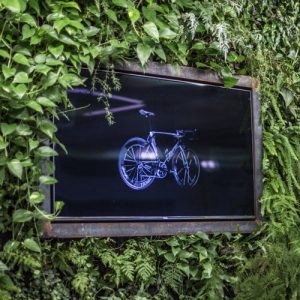 Eco Brooklyn Living Wall with Screen Enhancement.
Eco Brooklyn Living Wall with Screen Enhancement.
Naava, out of Finland, entered the living wall market in the United States back in 2017 and they provide a nice definition of green walls on their site along with useful information about the benefits of green walls. We love their tagline, ?RECONNECTING HUMANITY WITH NATURE.? Each word is so intentional and so important.
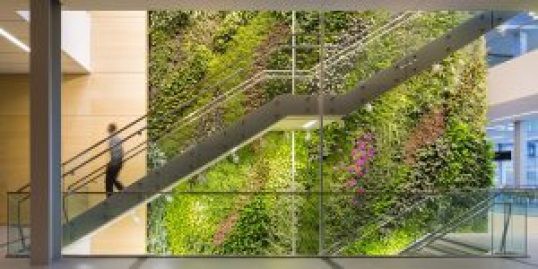 New Jersey Institute for Food Nutrition and Health at Rutgers College, New Brunswick, N.J. Architect: Ballinger Architects
New Jersey Institute for Food Nutrition and Health at Rutgers College, New Brunswick, N.J. Architect: Ballinger Architects
One of our favorite living walls (and one of the first of its scale) is in Canada at the University of Ottawa. The living wall in the Faculty of Social Science building is the tallest living biofilter in North America. The green wall is one example of the University?s sustainability projects.
You may have noted other references to Canada and Canadian companies in previous blog posts. I grew up in Ontario, Canada and we?re thrilled to announce that we are creating a custom moss installation for the soon to open Form Condos, a Tridel Building in downtown Toronto, next to OCAD. This project and collaboration came to us through Jamie Miller of Biomimicry Frontiers in Guelph, Ontario. We have also shipped a moss wall in panels for Tersano, Green cleaning supplies out of Windsor, Ontario. They wanted to save on shipping and weight (reduce that carbon footprint) so we shipped just the moss panels and the team at Tersano built the frame around it on their end.
We also did some research in Denver, Colorado and noted that there are some ?lighter? versions of living walls there that involve shelves of single potted plants that when combined, look really gorgeous. This piece at Let Em Have It Salon is stunning. Owner Fallene Wells and her team are also really lovely people and Fallene recently turned her enterprise into a B Corporation. Congrats on that Fallene.
Fallene told me she has a service that comes to maintain the plants on a regular/weekly schedule. We learned the same of the living walls we saw in the Rino District.
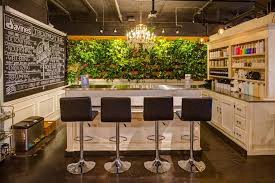 Living Wall at Let Em Have It Salon, Denver, Colorado.
Living Wall at Let Em Have It Salon, Denver, Colorado.
Like you would expect, living walls require water and attention which is why folks still look at us incredulously when we tell them our moss walls are maintenance-free.
What is a Moss Wall?
A moss wall, interestingly, is also called a green wall which is where the confusion can begin between the two. We construct our green walls aka moss walls with real, but preserved moss that does not require any dirt, soil or substrate, and does not require any watering or misting of any kind.
We explain it like this: a moss wall is neither living nor dead, it is made of moss that is dormant, having been preserved using a natural paraffin or glycerin process. Moss walls retain their lush look with zero maintenance (except for the occasional dusting using compressed air just as you would use on a computer keyboard) for at least ten years and we?re testing a natural spray that will extend the life of a moss wall indefinitely.
The Fat Plant Society moss is harvested in North Carolina and Kentucky and when it arrives, it smells just like standing in the middle of a forest. The moss has acorns and other treasures from its birthplace and we clean the moss before laying it out in our design studio. From there we use the moss just like a painter would use paint to achieve the colors, textures, and depth of each, handmade panel or piece.
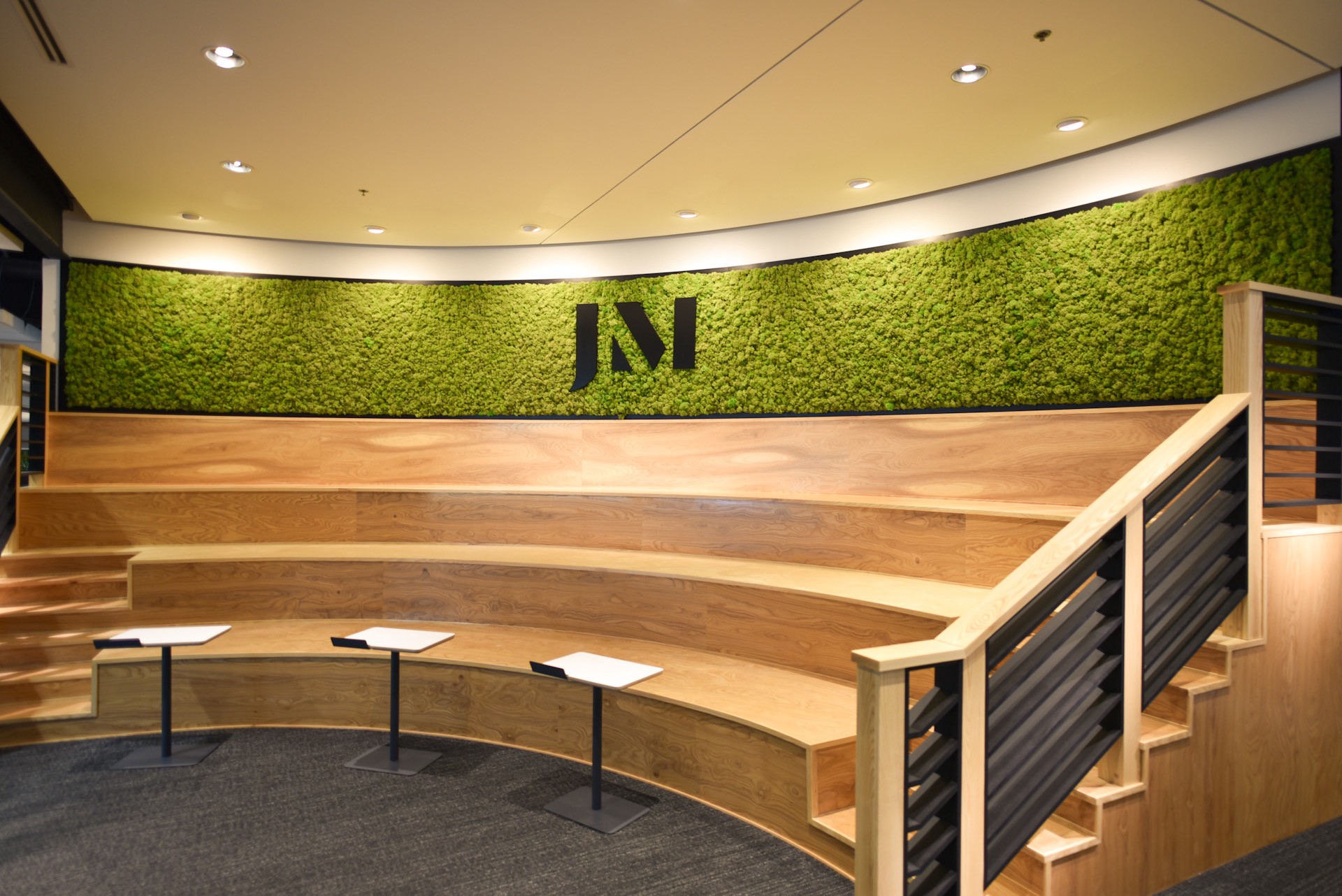 Curved Moss Wall created for Hive Design Collaborative for the John A. Marshall Company in Lenexa, Kansas.
Curved Moss Wall created for Hive Design Collaborative for the John A. Marshall Company in Lenexa, Kansas.
We use a few different kinds of moss to achieve the desired look and the moss we use depends on what the client is seeking in terms of the ?feel? of their moss wall or frame. The photo to the above is reindeer moss but we also use pillow moss and sheet moss and even layer the different types on top of each other or next to each other so as to provide the most biophilic look possible. Our designs tend toward the natural look, as you can see but we are also developing moss logos for our clients and if a client requests Day-glo, blue and yellow moss (We?re looking at you, University of Kansas) or black and gold (Now we?re looking at you, University of Iowa), then color they shall receive.
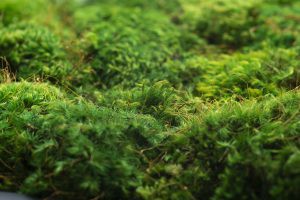 Pillow Moss
Pillow Moss
Sheet moss was one of the more commonly used mosses in the early days of moss walls because, well, it literally grows in sheets. But reindeer moss and pillow moss are our preferred mosses because they contain such depth of color and nuanced shades green. Pillow moss is replete with red hairs and varying shades of green as you can see in the photo. Contrast that look with the bright green of our reindeer moss (below) and you can imagine how exciting it is for us to select the type of moss that will bring the client?s vision to life (so to speak).
 CUSTOM HEART WITH KC LETTERING CREATED FOR VMLY&R. JP WELDING IN BELTON, MISSOURI CREATED THE FIVE FOOT BY THREE FOOT STEEL FRAME
CUSTOM HEART WITH KC LETTERING CREATED FOR VMLY&R. JP WELDING IN BELTON, MISSOURI CREATED THE FIVE FOOT BY THREE FOOT STEEL FRAME
From logos to walls to groupings of circular or square frames, moss draws people in and they cannot resist touching it. The good news is, you are more than welcome to touch it as our American grown and harvested moss (which we find is heartier than the mosses of Europe and the U.K.) is sturdy but soft to the touch.
How are Living Walls and Moss Walls the same?
Living walls and moss walls are the same in that they are both referred to as green walls and that is accurate on both counts. They are also the same in that both provide environmental benefits such as reduction of noise pollution and air pollution (moss walls absorb VOCs) but don?t just take our word for it, there are a number of articles that support the fact that moss, though preserved and dormant, is still providing many of the same benefits that living walls provide. In fact, since moss so porous, it absorbs VOCs extremely well and dampens sound (particularly medium to high voice frequencies) better than plants like phylodendron and the infamous snake plant.
How are they different?
Moss walls differ from living walls in that they do not need soil, watering or misting of any kind and the weight of a moss wall is less than 3 lbs per square foot in comparison to the 10?12 lbs per square foot weight of a living wall. They are also different in the sense that the living wall is literally that, living and needs care and attention on a weekly, if not daily basis. Real, preserved moss, on the other hand, requires little to no maintenance at all. Last, but certainly not least, as you may have noted in the articles we have linked to in this post, moss walls run roughly 40% less in installation costs than living walls and with zero maintenance. (We do offer repairs in the event someone drunkenly pulls a chunk right off the wall but we have yet to have that happen).
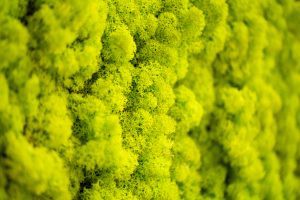 Reindeer Moss
Reindeer Moss
Which one is best for your needs depends largely on how much maintenance you want to (and have the budget to) provide to keep your green wall looking lush.
Living walls run up to $1,000 per month in maintenance depending on the size of the wall but you can expect to spend at least $3-$4K annually on maintenance for living plants at an impactful scale.
Moss walls, on the other hand, are a one-time development and installation cost with no maintenance costs associated. For more information and specs on The Fat Plant Society moss walls and designs, we invite you to download our spec sheet that provides detail on our moss and installation process.
Both living walls and moss walls have incredible visual appeal and provide numerous health benefits and frankly, we?re in love with both but have chosen moss (along with succulents) as our materials of choice at The Fat Plant Society.
So that?s the skinny folks. We can guarantee that bringing green into your workplace and living space has enormous benefits.
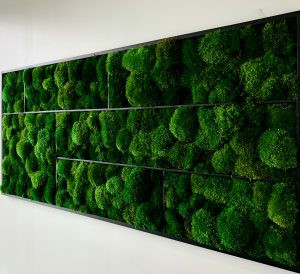 Pillow Moss in Planter Box Design for Isom Collective designing for (BRR Architecture)
Pillow Moss in Planter Box Design for Isom Collective designing for (BRR Architecture)
We never tire of looking at the moss and noting the changes in color as natural light and artificial light change throughout the day. We think it may have even made our stereo speakers sound better somehow but don?t ask us to definitively prove that one?And we also love our plants. From Namibian Bottle Trees to succulents to the Virginia Creeper that grows naturally in our urban garden, green makes us relax and smile. And we now know that green=well-being and that means biophilic design is becoming a matter of course.
There is more than one green option available to you and we could not be more thrilled about the ?greening? of spaces from rooftops to libraries to living rooms.
We answer more of your questions about Fat Plant Society Moss Walls on our FAQ and as always, feel free to email, DM or call to pose questions directly. We are always happy to talk and walk you through the process as well as provide pricing for custom walls and frames.
We also have standard size moss frames available for purchase on our Website (the skinny panel) in reindeer moss and we are working on a standard pillow moss and pole moss product. We do make every frame by hand so we ask for an eight-week turnaround on larger orders.
As with all living things, there is a season and we stock up on moss in the summer months so as to be able to provide moss all year round.
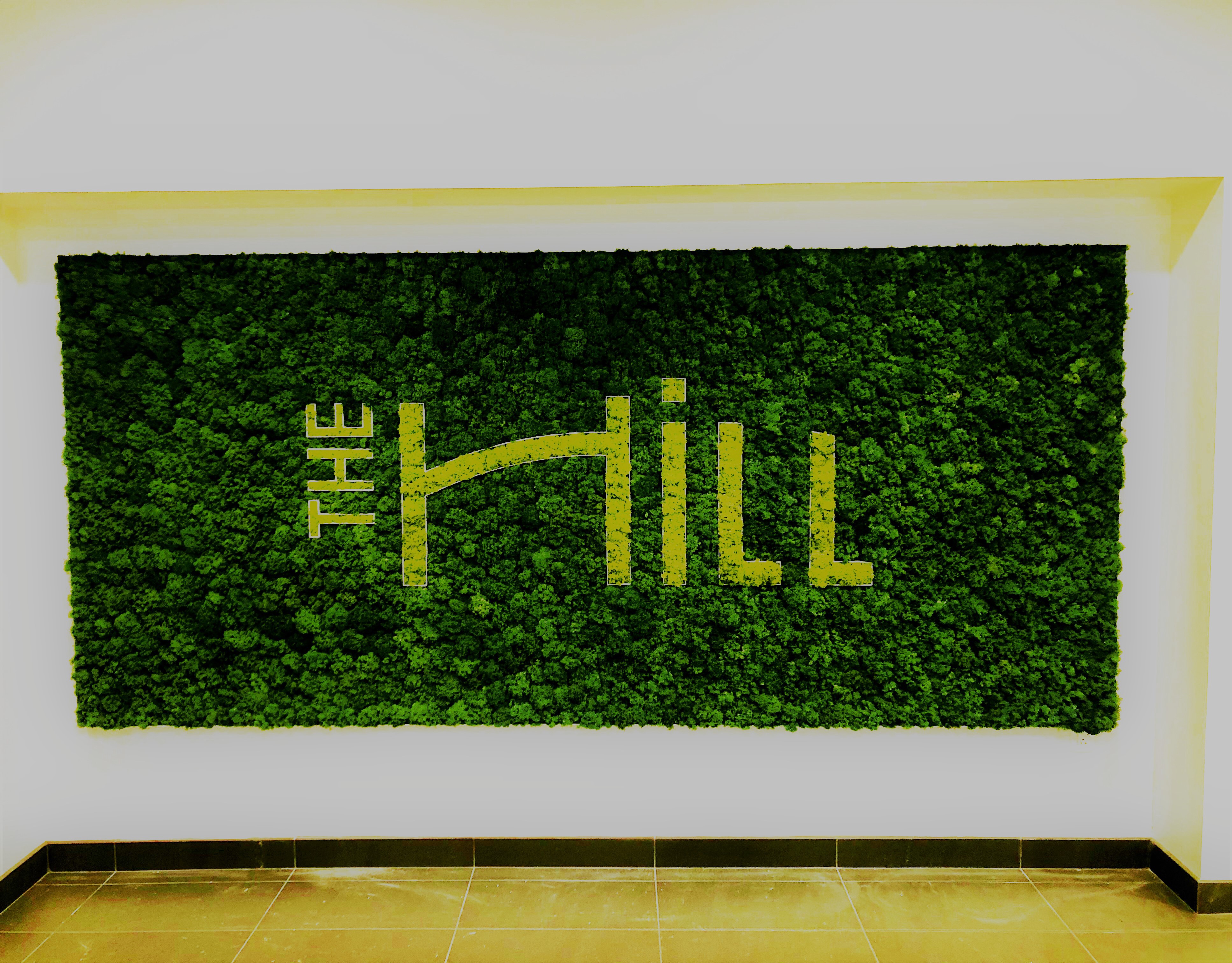 THE HILL. CREATED FOR UMB FEATURING BASIL GREEN AND CHARTREUSE REINDEER MOSS.
THE HILL. CREATED FOR UMB FEATURING BASIL GREEN AND CHARTREUSE REINDEER MOSS.
As always, yours in the love of all things green,
Kasey & Morten
The Fat Plant Society


